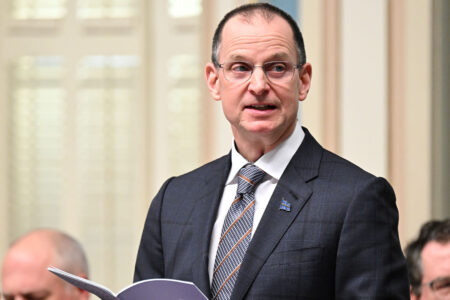
The remarkable results of the 2011 general federal election — the collapse of the Bloc Québécois, the rise of the NDP in Quebec and the advent of a Conservative majority government with scant Québécois representation — would in themselves be reason enough to revisit the status and future of Quebec in the Canadian federation. But if one sees these results as embedded in a larger national intellectual and policy-political context in which, some 20 years after the death of the Charlottetown Accord, an entire generation of political leaders and scholars outside of Quebec has been formed without any sustained immersion in, or indeed instinct for, questions relating to Quebec in general, and the Constitution in particular, then the basis for serious new-century reflection on Quebec in the Canadian federation acquires a far greater degree of solidity.
In Quebec, these same 20 years have, for many francophone Québécois, seen the emergence and intensification of a collective imagination that largely abstracts from Canada and the collective Canadian project. The consequence of this divergent imagination — or « social imaginary » as it were — is less the threat of a near-term national unity crisis (although the timing of the next unity crisis is somewhat unpredictable) than a growing disjuncture, if not outright stasis or paralysis, in the federal-provincial relations between Ottawa and Quebec and, more broadly, a near-total opting-out by Quebec from national policy discourses and debates. In turn, an arguably facile assumption that Quebec will usually not form part of large-scale or ambitious pan-Canadian policy initiatives has set in among political and policy leaders in Ottawa and a number of provincial capitals. The degree to which such thinking is self-fulfilling is difficult to gauge, although it is probably responsible for the relative dearth of major pan-Canadian public initiatives (and of proper First Ministers’ Meetings) over the last couple of decades.
So what is the nature of the « Quebec question » at this early juncture of Canada’s third century? It is at this juncture arguably still of a defensive or de minimis character — to wit, how do we ensure that the Canadian federation does not dissolve for the foreseeable future? This defensive posture does not presume to aim for an ideal federation or for any species of amity among the various parts of the Canadian federation. Rather, it presumes that the existence of Canada — built on a century and a half of tradition, reasonable civility and enviable material prosperity — is a public good that is worthy of strategic defence.
Such strategic defence does not necessarily rely on the continued balance of reasoned intellectual or policy arguments in favour of the continued existence of the Canadian state, but it does presume the necessity of a balance of popular and political forces across the country — brute or enlightened — consistently favouring union over secession or dissolution.
There is little doubt that the constitutional question still forms a central part of the political discourse in Quebec, although no longer in the rest of Canada (unless we speak of, say, Senate reform). This question has both substantive and strategic/tactical aspects. Substantially, if there is a constitutional « fix » to the unity question as it concerns Quebec, what would it be? Tactically, how would such a fix be implemented, given the complexities of constitutional reform in Canada? And strategically, what are the costs of failure in such Quebec-centred constitutional reform? Or, in other words, might the costs of a failed attempt at reform — resulting in, say, the breakup of the country following a clear « yes » majority in a referendum — militate altogether against any such attempt at constitutional reform in the first place?
There is little doubt that the constitutional question still forms a central part of the political discourse in Quebec, although no longer in the rest of Canada (unless we speak of, say, Senate reform).
In much of francophone Quebec, there remains a presumption that Quebec is somehow « outside » the Canadian constitutional framework by virtue of that province’s nonsignature of the Constitution Act, 1982 (which includes the Charter of Rights and Freedoms). In point of fact, Quebec is legally bound by that Constitution Act (and the Charter), just as it is by the rest of the Canadian Constitution, including those constitution acts — starting with the 1867 variant — to which it did formally assent. (Quebec also already enjoys asymmetric recognition in the Constitution in both the constitution acts and in constitutional jurisprudence.) If Quebec is already legally bound by all of the Constitution, even though it may not have assented to a part of the Constitution, then the germane question today is essentially nonlegal in nature; it is political — to wit, can any constitutional amendment at all attract sufficient support in Quebec to « lay to rest » — at least for the foreseeable future — any secessionist threat from that province? Or are the demands of Quebec secessionists and certain nationalists quintessentially « elastic, » so that they can never be sated by any constitutional amendment or indeed any other type of agreement, for that matter, with the federal government and/or the rest of Canada; that is, after the constitutional amendment, they morph to assume another form of demand for distinctive treatment for Quebec, and likely still with the same end goal of causing the secession of the province from Canada? If the latter is the case in practice, then there is little point in launching a process of Quebec-centred constitutional reform. If it is not the case — that is, if there is indeed a « fix » that could meaningfully foil or counter secessionist ambitions in Quebec for the foreseeable future — then what is that fix, and how would it be actualized?
It would seem, prima facie, that any constitutional amendment seeking to « recognize » — or further « recognize » — the distinctiveness or specificity of Quebec, explicitly or implicitly, would depend on either or both of sections 38 and 43 of the Constitution Act, 1982. The former is the 7/50 (general amendment) formula, which applies to amendments affecting all provinces, while the latter allows for bilateral or multilateral amendments (i.e., between the federal government and concerned provinces) strictly in cases where only one province or a restricted group of provinces is touched by the amendment. The section 38 variant is the one that failed at Meech (and was effectively rejected in the Charlottetown referendum). The section 43 variant is the one that was used for numerous bilateral constitutional amendments in the 1990s by the Chrétien government to address various province-specific issues, including in one instance for Quebec, in 1997.
Large-scale or « structural » amendments to the Constitution, such as those contained in the failed Meech Lake Accord of 1987 and largely anticipated by the five demands of then Quebec premier Robert Bourassa (and, before him, the five demands of Quebec Liberal leader Claude Ryan) would evidently require use of the 7/50 amending formula. Demands for recognition of the distinctiveness or specificity of Quebec society, a provincial veto over future constitutional amendments, a role for the province in the appointment of Supreme Court justices or senators, increased immigration power for the province and restrictions on the use of the federal spending power would all require passage of the amending resolution in the House of Commons and Senate, as well as in the legislatures of at least seven provinces representing at least 50 percent of the Canadian population, within three years’ time. If we assume that such ambitious and « comprehensive » amendments to the Constitution would, if passed, put paid to any foreseeable national unity threats to Canada, then we might just as well presume that failure to pass them, as was the case with Meech and Charlottetown, would gravely jeopardize the survival of the federation, given the expected backlash in Quebec and the associated likelihood of a dramatic surge in sovereigntist activism and an ultimate referendum on secession. The procedural difficulty of meeting the 7/50 standard within three years just on its face is compounded by the post-Meech and post-Charlottetown advent of provincial laws requiring referenda in relation to proposed constitutional amendments, as well as the still extant 1996 federal Act Respecting Constitutional Amendments, which provides that proposals for certain constitutional amendments (particularly 7/50 amendments) must be consented to by a majority of the provinces, including Quebec, Ontario, British Columbia, at least two of the Atlantic provinces making up at least 50 percent of Atlantic Canada’s population, and at least two of the Prairie provinces making up at least 50 percent of the Prairie population. And so the expected « fix » to Canada’s national unity issue in the aftermath of such a major section 38 constitutional amendment must be assessed in the light of the expected failure of the process leading up to the « fix » moment. That such a failed process would probably result in the breakup of the country signifies that the expected benefit of the amendment (low probability x high benefit) is outweighed by the expected cost of failure (high probability x high cost).
In much of francophone Quebec, there remains a presumption that Quebec is somehow “outside” the Canadian constitutional framework by virtue of that province’s nonsignature of the Constitution Act, 1982 (which includes the Charter of Rights and Freedoms). In point of fact, Quebec is legally bound by that Constitution Act (and the Charter).
What of section 43 fixes between Ottawa and specific provinces affected by particular amendments? Section 43 amendments could certainly not cover the ambitious ground of the section 38 amendments (i.e., in meeting the totality of Quebec’s effective or implied « asks »), but a few section 43 scenarios could go some way in meeting some of these « asks. » Moreover, because these scenarios would principally be bilateral in nature — that is, requiring only the support of the House of Commons, the Senate and the Assemblée Nationale — successful passage of the amendments may not prove prohibitively difficult. José Woehrling’s terrific 2001 study, « Les aspects juridiques de la redéfinition du statut politique et constitutionnel du Québec, » lists the various sections of the Constitution Act, 1867 that are susceptible to such amendment, ultimately positing possible important and juridically defensible amendments relating specifically to sections 133 and 94 of the Constitution Act, 1867 (both sections, en passant, already indicative of Quebec’s constitutionalized distinctiveness). Section 133, for instance, might reasonably and credibly be amended to, say, include an interpretative clause (not dissimilar in wording to the one at Meech) relating to a duty of the government of Quebec and the Assemblée nationale to protect and promote the French language. Similarly, section 94 might be amended to, say, assert the duty of the government of Quebec and the Assemblée nationale to protect and promote the distinct character of the civil law in Quebec. These two amendments, in the aggregate, would not necessarily address all of the various dimensions of Quebec’s distinctiveness intended by the famous « distinct society » clause at Meech, but positive constitutional assertions of distinctiveness in two of the key dimensions — language and law — would potentially sate (sustainably sate) a critical mass of Quebecers who would otherwise be in the sovereignist camp. Moreover, these bilateral amendments would not necessarily attract some of the said extra-constitutional procedural barriers at play in section 38 amendments, such as a provincial referendum in Quebec on this amendment. (There would also evidently be no referenda in other provinces — as they would not be directly implicated in the amendments — as would be the case with section 38 amendments.) And, of course, the federal law on regional vetoes would not apply to a section 43 amendment.
Granted, there might be strong political and public reaction from outside of Quebec to such special or « asymmetric » or even « backdoor » (formal and additional) recognition of aspects of Quebec’s distinctiveness. And there might well be discontent, if not muscular opposition, in Quebec to the said effect that the bilateral amendments do not address the totality of Quebec’s « traditional » multiplepart asks. If this Quebec-specific opposition succeeds in foiling the amendment, we might presume that it would not be sufficient to cause a unity crisis that would issue in a referendum — as this « rejection » would not come from the outside. Of course, we might be wrong in this presumption. (More certainly, if the rejection ultimately comes from Parliament — that is, from outside of Quebec — then a serious unity crisis could not be excluded.) And indeed some of this discontent could endure in Quebec — for at least a material segment of the population — beyond the successful passage of the amendments, meaning that the « fix » would not be total, and future « asks » very possible. At the same time, however, it is not impossible that these amendments, while suboptimal vis-à-vis Quebec’s historical asks, may well provide a « fix » for some time to come. And, most importantly, the expected costs of failure of these bilateral amendments (medium probability x medium cost) would be outweighed by the expected benefits of success (medium probability x high benefit).
Tactically, we might note that, given that the failure of such bilateral amendments would likely not be fatal to the federation, both Ottawa and Quebec could continue to « try again, » as it were, in the event of an initial failed attempt — always on the premise that the expected benefits continue to outweigh the expected costs, even if indecisively so.
The substantial absence of such regular engagement and interaction today between the rest of Canada and Quebec can only mean that moves relating to Quebec in general, and the Constitution in particular, are embedded in a decisionmaking culture that, on the Quebec question, is impoverished and untested.
Whether the public preparation or media buildup, in Quebec and the rest of Canada, ought to be significant in advance of the attempted passage of the amendments is an open question that will certainly play with the probability of passage and the amplitude of failure and success. But what is clear is that a successful amendment that seeks to provide a « fix » will certainly need to be known to Quebecers as both existing and as having aimed to address Quebec’s historical « asks. » Having said this, if we agree that Quebec and the rest of Canada currently have (and have by now long had) very separate political and sociocultural imaginations, it does not necessarily follow that the constitutional « fix » must result in a unified, panCanadian social imagination. That is, from a strictly defensive or de minimis standpoint, national unity does not require uniformity of imagination among Canada’s constituent parts: it simply requires, as established above, a sustained preponderance of popular forces in favour of preserving the federation over forces opposed to such preservation.
More problematic, however, for the defensive posture (and for the — offensive » posture briefly discussed below) is the aforementioned development, outside of Quebec, of an entire new generation of policy and political leaders who have negligible experience of, interest in and instinct for the Quebec question in Canadian affairs — most notably in relation to the Canada-Quebec constitutional « dances » that preoccupied previous generations of Canadian public leaders. These past « dances » — even if often inelegant — had the effect of establishing familiarity and, in many cases, friendships and mutual understanding between public players in Quebec and the rest of Canada. Even if they did not issue in a pan-Canadian imagination, regular engagement and interaction with « the other » provided the requisite context and decision-making culture for proper evaluation of the expected costs and benefits — and associated tactics — of particular moves related to the Constitution, and indeed for extraconstitutional moves involving Quebec.
The substantial absence of such regular engagement and interaction today between the rest of Canada and Quebec can only mean that moves relating to Quebec in general, and the Constitution in particular, are embedded in a decision-making culture that, on the Quebec question, is impoverished and untested. The expected costs and benefits of such moves may, in the event, be improperly assessed, and the associated tactics ill-conceived. In the worst case, a constitutional « fix » might be overestimated, the costs to the federation of failure underestimated, and improper tactics (say, insufficient public buildup or clumsy linkages between Quebec-specific amendments and more general amendments, like Senate reform, à la Charlottetown) fatal to the federation. In a less worse case, a constitutional « fix » might be underestimated, and the costs of failure overestimated — in other words, a lost opportunity.
All of this suggests that the defensive posture will require the re-creation of a serious, pan-Canadian decision-making culture for dealing with Quebec and its place in the Canadian federation. The necessity of such a renewed Canada-Quebec administrative culture is all the more plain as we move from the defensive to the « offensive, » as it were: that is, as we consider prospects for the achievement of bona fide panCanadian policy objectives, ranging from matters economic to education, languages, health care, the environment, the Aboriginal condition and international performance. (It is not inconceivable that the achievement of pan-Canadian policy goals should be pursued before, and even independently of, any potential constitutional « fix » or calculus implied by the defensive posture.) Three key moves (or directions) suggest themselves as possible drivers in this cultural renewal on the Quebec question and advancement of an « offensive, » pan-Canadian policy agenda:
- First, the re-establishment of a standing First Ministers’ Meeting or conference (see my article in Policy Options‘ September 2008 issue), chaired by the Prime Minister, supported by and giving « marching orders » to interlocking, highlevel federal-provincial bureaucratic committees operating on the basis of an « indefinite game, » rather than on ad hoc and one-off transactions;
- Second, the deliberate fostering over time of a far greater degree of interdependence, professional familiarity, collegiality and « interlockedness » among the policy elites or leaders of the federal and provincial governments (as well in Aboriginal and municipal governments), including active rotation of upper-level civil servants between the federal and provincial civil services, as well as between the provincial civil services, and the possible establishment of a Canada-wide Canadian academy of public service to train future top federal and provincial servants.
- Third, and most controversially, defence and resuscitation of the federal spending power — perfectly legal at constitutional law — as a legitimate and necessary instrument of the federal government in achieving pan-Canadian policy objectives even in areas of primary provincial interest (see my May 2011 Policy Options article on a 21st-century national languages strategy), just as — complexité oblige — provincial governments promiscuously employ provincial spending powers to advance province-specific objectives in areas of primary federal interest (e.g., foreign affairs or international trade).








